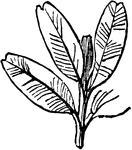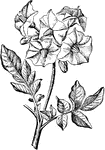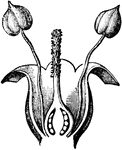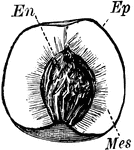
Root-Grafting of Dahlia
Grafting is a method of asexual plant propagation widely used in agriculture and horticulture where…

Root-Grafting of Woody Plant
Grafting is a method of asexual plant propagation widely used in agriculture and horticulture where…

Propagation by Cuttings
Plant propagation is the process of artificially or naturally distributing plants. Pictured here is…
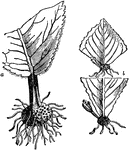
Leaf Cuttings
Plant propagation is the process of artificially or naturally distributing plants. Pictured here is…
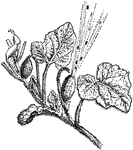
Squirting Cucumber
The Squirting or Exploding Cucumber (Ecballium elaterium) is a cucumber plant named for squirting a…
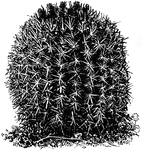
Coast Barrel Cactus
The Coast Barrel Cactus (Ferocactus viridescens) is a cactus seen throughout southern California.

Southern Globe Thistle
The Southern Globe Thistle (Echinops ruthenicus) is a species of thistles in the Asteraceae or daisy…
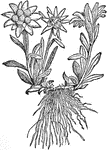
Edelweiss
Edelweiss (Leontopodium alpinum) is a European mountain flower of the Asteraceae or daisy family.
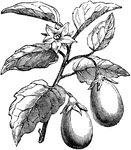
Eggplant
The Eggplant (Solanum melongena) is a flowering plant in the Solanaceae family of nightshades. Its fruit…

Fumitory
Fumaria is a genus of about fifty annual herbaceous flowering plants in the family Fumariaceae, native…

Fumitory (Side-view)
An illustration of the side-view of the fumitory flower Fumaria is a genus of about fifty annual herbaceous…

Fumitory Flower (Longitudinal Section)
An illustration of a longitudinal section of the fumitory flower. Fumaria is a genus of about fifty…

Cardamine
An illustration of: A, Inflorescence and cauline leaves; B, Radical leaves and root. Cardamine (Car-dá-mi-ne,…
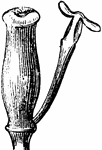
Pistil and Stamen of Burberis
An illustration of the a stamen and pistil of the berberis plant. Berberis (Bér-be-ris, barberry,…

Oleaster
"Flowering Branch of Oleaster (Elaeagnus angustifolia). a, fruit; b, section of same." -Whitney, 1911

elecampane
The Elecampane (Inula helenium) is a flowering plant in the Asteraceae family of daisies.
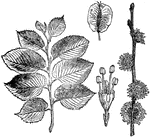
English Elm
Now known as Ulmus procera, the image shows a "Flowering Branch and Foliage of English Elm (Ulmus campestris),…

Carrot Flower
An illustration of the inflorescence of the carrot plant. An inflorescence is a group or cluster of…

Fructification of Carrot Flower
An illustration of fructification of the carrot flower. Fructification is a term used in the plant morphology…
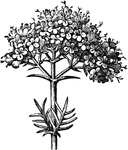
Valerian Inflorescence
Valerian is a hardy perennial flowering plant, with heads of sweetly scented pink or white flowers.…

Valerian Flower
Valerian is a hardy perennial flowering plant, with heads of sweetly scented pink or white flowers.…

Valerian Flower (Longitudinal Section)
An illustration of a longitudinal sectional view of the valerian flower. Valerian is a hardy perennial…

Valerian Seed with Pappus
An illustration of the valerian seed with attached pappus. In a composite flower, Pappus is the part…
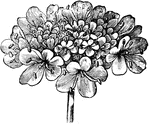
Inflorescence of Field Scabious
An illustration of the inflorescence of the field scabious. Knautia arvensis, commonly known as Field…
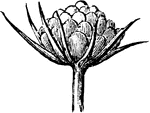
Young Inflorescence of Field Scabious
An illustration of the young inflorescence of the field scabious. Knautia arvensis, commonly known as…

Ray-floret of Field Scabious
An illustration of a ray-floret of the field scabious. Knautia arvensis, commonly known as Field Scabious,…

Ray-floret of Field Scabious
An illustration of a ray-floret of the field scabious. Knautia arvensis, commonly known as Field Scabious,…

Seed of Field Scabious
An illustration of the seed of the field scabious. Knautia arvensis, commonly known as Field Scabious,…

Inflorescence of a Cornflower
An illustration of the inflorescence of the cornflower. Centaurea cyanus ('Cornflower, Bachelor's button,…

Ray-floret of a Cornflower
An illustration of a ray-floret of the cornflower. Centaurea cyanus ('Cornflower, Bachelor's button,…
Disk-floret of a Cornflower
An illustration of a disk-floret of the cornflower. Centaurea cyanus ('Cornflower, Bachelor's button,…
Disk-floret of a Cornflower (Longitudinal
An illustration of a longitudinal section view of a disk-floret of the cornflower. Centaurea cyanus…
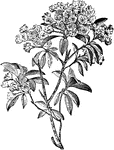
Mountain-laurel
Kalmia latifolia, commonly called Mountain-laurel or Spoonwood, is a flowering plant in the family Ericaceae,…

Viper's Bugloss Inflorescence
Echium vulgare (Viper's Bugloss) is a species of Echium native to most of Europe, and western and central…

Viper's Bugloss Flower
Echium vulgare (Viper's Bugloss) is a species of Echium native to most of Europe, and western and central…
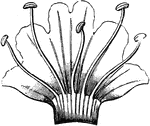
Viper's Bugloss Corolla and Stamens
Echium vulgare (Viper's Bugloss) is a species of Echium native to most of Europe, and western and central…
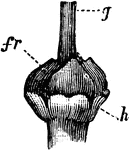
Gynaeceum of Viper's Bugloss
An illustration of the Gynaeceum of the viper's bugloss. Fr, ovary; g, base of style; h, honeyglands.
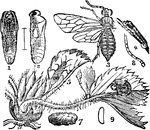
Strawberry Sawfly
"Strawberry False-worm (Emphytus maculatus). 1, 2 pupa, ventral and lateral views (line shows natural…
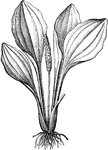
Plantain Flower
An illustration of a plantain plant. The plantain is a crop in the genus Musa and is generally used…

Plantain Flower and Bract
An illustration of a plantain plant flower and bract. In botany, a bract is a modified or specialized…
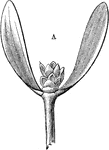
Mistletoe Flower
An illustration of the flower of the mistletoe plant. Mistletoe is the common name for a group of hemi-parasitic…
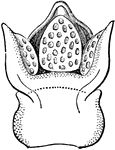
Mistletoe Staminate
An illustration of one staminate flower in section, magnified twelve times. Mistletoe is the common…
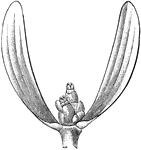
Pistillate Flowers of Mistletoe
An illustration of pistillate flowers of mistletoe. Mistletoe is the common name for a group of hemi-parasitic…
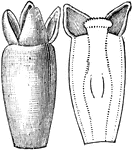
One Pistillate Flower of Mistletoe
An illustration of one pistillate flower of mistletoe. Mistletoe is the common name for a group of hemi-parasitic…

Mistletoe Attached to Host Plant
An illustration of a mistletoe plant attached to the host plant. Mistletoe is the common name for a…

Sedge
An illustration of the female flower of the sedge plant. Carex is a genus of plants in the family Cyperaceae,…
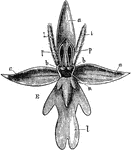
Fly Orchid
Fly orchid (Ophrys insectifera) is a plant of the family Orchidaceae, a native of the British Isles…

Turk's Cap Lily
Lilium martagon (Martagon or Turk's cap lily) is a species of lily. It has a widespread native region…

Lily of the Valley
Convallaria majalis, commonly known as the Lily of the Valley or Lily-of-the-Valley, is the only species…
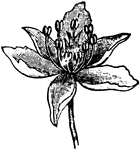
Flowering Rush
The flower of the Flowering Rush (Butomus umbellatus), the sole species in the Butomaceae family.
